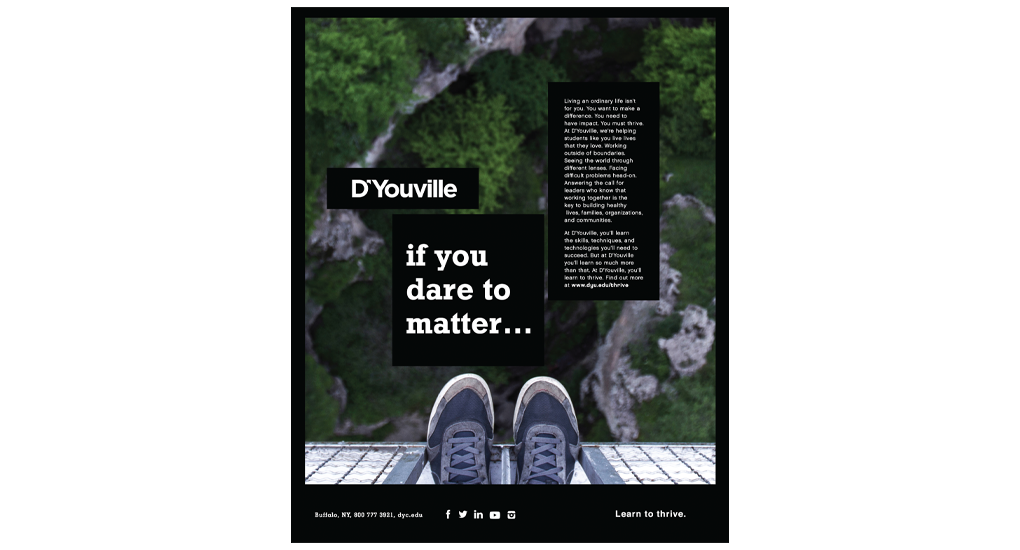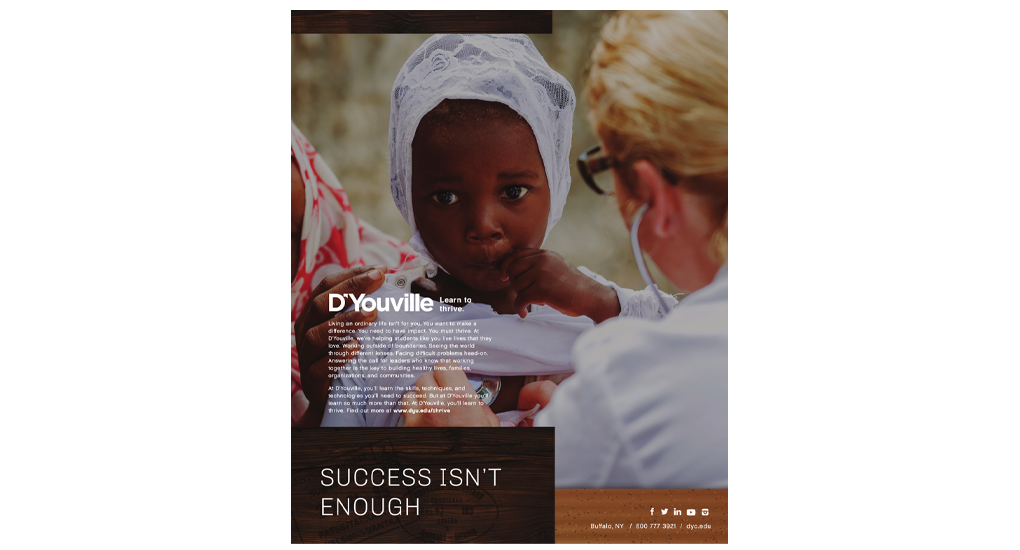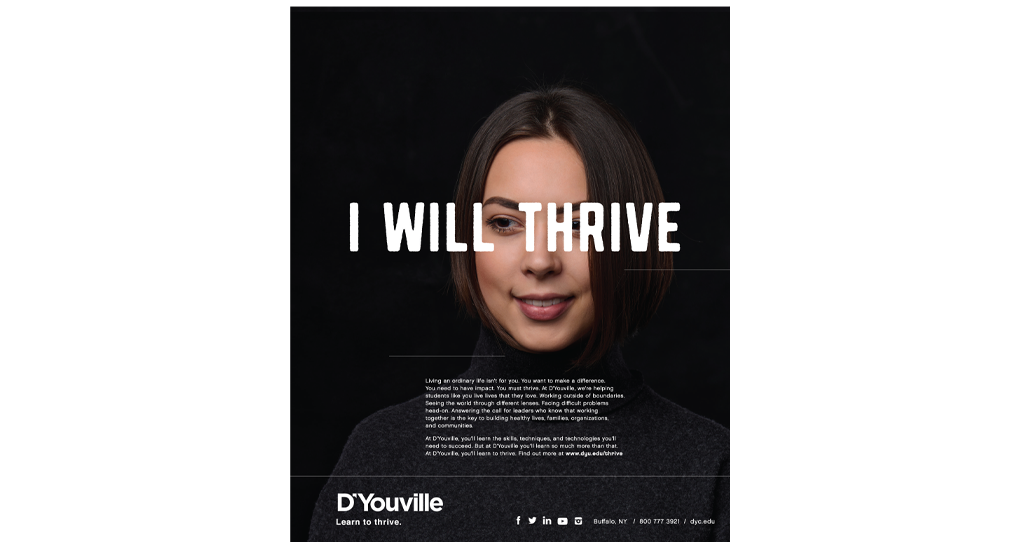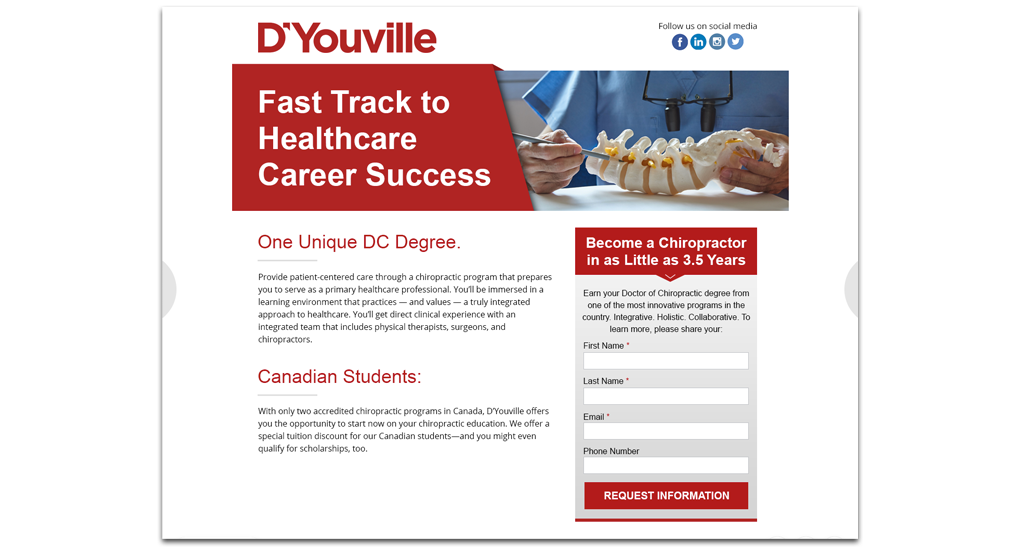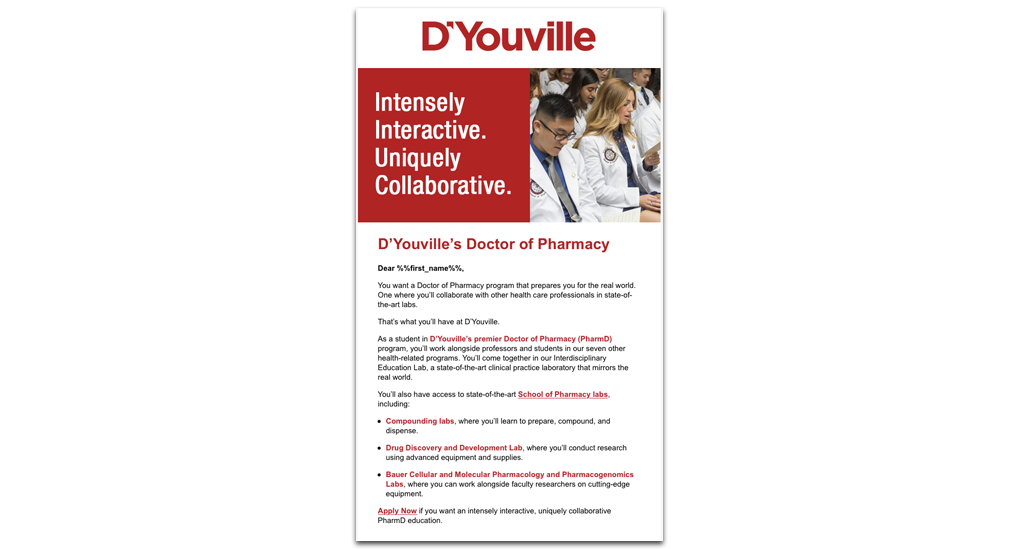D’Youville College
Healthcare-focused DYC delivers career-ready graduates. Find out how demand generation helped them win market share from bigger brands.

Like many of its peers, D’Youville College (DYC)—a small Catholic liberal arts institution in Buffalo, NY—struggled with mounting enrollment pressures and increasing competition from public colleges and universities.
However, unlike its peers, healthcare-focused DYC produces graduates who get good jobs quickly after graduation.
In fact, the school offers some of the best student outcomes in Western NY. DYC needed to break through the clutter of messages from competing institutions, many of which had deeper pockets and more widely-known brands.
Stamats implemented a three-tier demand generation strategy that focused on awareness, engagement, and conversion:
Awareness
After initial discovery conversations, we realized DYC needed compelling and relevant language to describe precisely why the college should be on prospective students’ consideration lists.
The first step was to build out a messaging platform that would resonate with each of DYC’s target audiences.
DYC did not have the budget to conduct large-scale brand awareness campaigns. So, we identified four major programs with the best opportunity for increased enrollment. The idea was to create a “halo” effect for other DYC offerings, positioning DYC as a leader in healthcare professional education.
We began to market these programs through paid digital outreach (primarily search engine marketing) within DYC’s footprint of Western New York, Southern Ontario, Northwestern Pennsylvania, and Eastern Ohio. Because this was DYC’s first foray into program marketing, we wanted media that was trackable, easily optimizable, and cost-effective.
Engagement
The digital outreach led to landing pages that were created specifically for each of the four major programs. Our goal was to create a “directed experience.”
Rather than expecting interested prospects to wander around the DYC website, these landing pages spoke directly to program benefits through testimonials, fast facts, and outcomes-focused content. The goal was to get interested students to complete a simple “request for information” form that asked only for a prospect’s name and email address.
Conversion
Once prospective students completed the form, they were placed into program-specific “nurture streams.” Prospects received key content tied to their point in the enrollment journey.
The strategic content focused on various topics ranging from outcomes, to the student experience, to faculty interaction. With each communication, prospects were offered the opportunity to “apply now.”
The initial program targeted prospective candidates for the chiropractic (direct admit), pharmacy, health administration, and health analytics programs.
Because of the early success of these efforts, DYC has launched similar marketing initiatives for veterans, Doctor of Chiropractic (professional), and intensive English preparation for foreign students.
These strategies have made it easy for students to receive information and to receive sufficient data for ongoing nurturing that will streamline this process.
-
The Challenge
Like many of its peers, D’Youville College (DYC)—a small Catholic liberal arts institution in Buffalo, NY—struggled with mounting enrollment pressures and increasing competition from public colleges and universities.
However, unlike its peers, healthcare-focused DYC produces graduates who get good jobs quickly after graduation.
In fact, the school offers some of the best student outcomes in Western NY. DYC needed to break through the clutter of messages from competing institutions, many of which had deeper pockets and more widely-known brands.
-
The Project
Stamats implemented a three-tier demand generation strategy that focused on awareness, engagement, and conversion:
Awareness
After initial discovery conversations, we realized DYC needed compelling and relevant language to describe precisely why the college should be on prospective students’ consideration lists.
The first step was to build out a messaging platform that would resonate with each of DYC’s target audiences.
DYC did not have the budget to conduct large-scale brand awareness campaigns. So, we identified four major programs with the best opportunity for increased enrollment. The idea was to create a “halo” effect for other DYC offerings, positioning DYC as a leader in healthcare professional education.
We began to market these programs through paid digital outreach (primarily search engine marketing) within DYC’s footprint of Western New York, Southern Ontario, Northwestern Pennsylvania, and Eastern Ohio. Because this was DYC’s first foray into program marketing, we wanted media that was trackable, easily optimizable, and cost-effective.
Engagement
The digital outreach led to landing pages that were created specifically for each of the four major programs. Our goal was to create a “directed experience.”
Rather than expecting interested prospects to wander around the DYC website, these landing pages spoke directly to program benefits through testimonials, fast facts, and outcomes-focused content. The goal was to get interested students to complete a simple “request for information” form that asked only for a prospect’s name and email address.
Conversion
Once prospective students completed the form, they were placed into program-specific “nurture streams.” Prospects received key content tied to their point in the enrollment journey.
The strategic content focused on various topics ranging from outcomes, to the student experience, to faculty interaction. With each communication, prospects were offered the opportunity to “apply now.”
-
The Results
The initial program targeted prospective candidates for the chiropractic (direct admit), pharmacy, health administration, and health analytics programs.
Because of the early success of these efforts, DYC has launched similar marketing initiatives for veterans, Doctor of Chiropractic (professional), and intensive English preparation for foreign students.
These strategies have made it easy for students to receive information and to receive sufficient data for ongoing nurturing that will streamline this process.


